Synergistic Impacts of Land Deformation and Rapid Socio-Ecological Changes on Disaster Risk in Indonesian Alluvial Plains Using Multiple Satellite Datasets
Abstract
1. Introduction
2. Materials and Methods
2.1. Overall Methodological Workflow
2.2. Study Area
2.3. Satellite Imagery
2.3.1. Sentinel-1 Series
2.3.2. Landsat Series
2.3.3. PlanetScope Series
2.3.4. Auxiliary Data
2.4. Data Processing
2.4.1. Differential Interferometry Using Sentinel-1 Datasets
2.4.2. Assessment of Urban Growth, Lake Shrinkage, and Agricultural Development Using Landsat and PlanetScope Series
2.5. Data Validation
2.5.1. Validation of Land Deformation Results with Global Navigation Satellite System Data
2.5.2. Landcover Classification and Accuracy Assessment
2.6. Correlation Analysis Between Land Deformation and Landcover
3. Results
3.1. Spatial Distribution of Sentinel-1 DInSAR Derived Land Deformatin Results
3.2. Comparison Between DInSAR Results and GNSS Data
3.3. Time Series Landcover Transformations
4. Discussion
4.1. Time Series Analysis of Vertical Land Deformation and Rapid Socio-Ecological Changes
4.2. Consequences of Land Deformation in Combination of Rapid Socio-Ecological Changes
4.3. Limitations
5. Conclusions
Author Contributions
Funding
Institutional Review Board Statement
Informed Consent Statement
Data Availability Statement
Acknowledgments
Conflicts of Interest
References
- Buffardi, C.; Ruberti, D. The Issue of Land Subsidence in Coastal and Alluvial Plains: A Bibliometric Review. Remote Sens. 2023, 15, 2409. [Google Scholar] [CrossRef]
- Raspini, F.; Caleca, F.; Del Soldato, M.; Festa, D.; Confuorto, P.; Bianchini, S. Review of satellite radar interferometry for subsidence analysis. Earth-Sci. Rev. 2022, 235, 104239. [Google Scholar] [CrossRef]
- Bokhari, R.; Shu, H.; Tariq, A.; Al-Ansari, N.; Guluzade, R.; Chen, T.; Jamil, A.; Aslam, M. Land subsidence analysis using synthetic aperture radar data. Heliyon 2023, 9, e14690. [Google Scholar] [CrossRef] [PubMed]
- Fabris, M.; Cenni, N.; Fiaschi, S. Editorial for Special Issue “Monitoring Land Subsidence Using Remote Sensing”. Remote Sens. 2021, 13, 1771. [Google Scholar] [CrossRef]
- Chaussard, E.; Amelung, F.; Abidin, H.; Hong, S.H. Sinking cities in Indonesia: ALOS PALSAR detects rapid subsidence due to groundwater and gas extraction. Remote Sens. Environ. 2013, 128, 150–161. [Google Scholar] [CrossRef]
- U.S. Geological Survey. Measuring Land Subsidence from Space. Available online: https://pubs.usgs.gov/fs/fs-051-00/pdf/fs-051-00.pdf (accessed on 17 April 2025).
- Bagheri-Gavkosh, M.; Hosseini, S.M.; Ataie-Ashtiani, B.; Sohani, Y.; Ebrahimian, H.; Morovat, F.; Ashra, S. Land subsidence: A global challenge. Sci. Total Environ. 2021, 778, 146193. [Google Scholar] [CrossRef]
- Solari, L.; Ciampalini, A.; Raspini, F.; Bianchini, S.; Moretti, S. PSInSAR Analysis in the Pisa Urban Area (Italy): A Case Study of Subsidence Related to Stratigraphical Factors and Urbanization. Remote Sens. 2016, 8, 120. [Google Scholar] [CrossRef]
- Jones, C.E.; An, K.; Blom, R.G.; Kent, J.D.; Ivins, E.R.; Bekaert, D. Anthropogenic and geologic influences on subsidence in the vicinity of New Orleans, Louisiana. J. Geophys. Res.: Solid Earth 2016, 121, 3867–3887. [Google Scholar] [CrossRef]
- Li, B.; Wang, Z.M.; An, J.C.; Zhou, C.X.; Ma, Y.Y. Time-Series Analysis of Subsidence in Nanning, China, Based on Sentinel-1A Data by the SBAS InSAR Method. J. Photogramm. Remote Sens. Geoinf. Sci. 2020, 88, 291–304. [Google Scholar] [CrossRef]
- Abidin, H.Z.; Andreas, H.; Gumilar, I.; Sidiq, T.P.; Fukuda, Y. Land subsidence in coastal city of Semarang (Indonesia): Characteristics, impacts and causes. Geomat. Nat. Haz. Risk 2013, 4, 226–240. [Google Scholar] [CrossRef]
- Serhalawan, Y.; Chen, P.F. Seismotectonics of Sulawesi, Indonesia. Tectonophysics 2024, 883, 230366. [Google Scholar] [CrossRef]
- Hall, R. Late Jurassic-Cenozoic reconstructions of the Indonesian region and the Indian Ocean. Tectonophysics 2012, 570, 1–41. [Google Scholar] [CrossRef]
- Walpersdorf, A.; Rangin, C.; Vigny, C. GPS compared to long-term geologic motion of the north arm of Sulawesi. Earth Planet. Sci. Lett. 1998, 159, 47–55. [Google Scholar] [CrossRef]
- Walpersdorf, A.; Vigny, C.; Manurung, P.; Subarya, C.; Sutisna, S. Determining the Sula block kinematics in the triple junction area in Indonesia by GPS. Geophys. J. Int. 1998, 135, 351–361. [Google Scholar] [CrossRef]
- Susilo, S.; Salman, R.; Hermawan, W.; Widyaningrum, R.; Wibowo, S.T.; Lumban-Gaol, Y.A.; Meilano, I.; Yun, S.H. GNSS land subsidence observations along the northern coastline of Java, Indonesia. Sci. Data 2023, 10, 421. [Google Scholar] [CrossRef]
- Japan International Cooperation Agency. Summary: The Study on Flood Control and Water Management in Limboto-Bolango-Bone Basin; Final Report Volume-II Main Report; Japan International Cooperation Agency: Tokyo, Japan, 2002. [Google Scholar]
- Kimijima, S.; Sakakibara, M.; Amin, A.M.A.; Nagai, M.; Arifin, Y.I. Mechanism of the Rapid Shrinkage of Limboto Lake in Gorontalo, Indonesia. Sustainability 2020, 12, 9598. [Google Scholar] [CrossRef]
- Druce, S.C. The Lands West of the Lakes; KITLV Press: Leiden, The Netherlands, 2009. [Google Scholar]
- Katili, J.A. Past Anr Present Getectonic Indonesia Position of Sulawesi, Indonesia. Tectonophysic 1978, 45, 289–322. [Google Scholar] [CrossRef]
- Kimijima, S.; Nagai, M. High Spatiotemporal Flood Monitoring Associated with Rapid Lake Shrinkage Using Planet Smallsat and Sentinel-1 Data. Remote Sens. 2023, 15, 1099. [Google Scholar] [CrossRef]
- Du, Y.; Xue, H.P.; Wu, S.J.; Ling, F.; Xiao, F.; Wei, X.H. Lake area changes in the middle Yangtze region of China over the 20th century. J. Environ. Manag. 2011, 92, 1248–1255. [Google Scholar] [CrossRef]
- Casagli, N.; Intrieri, E.; Tofani, V.; Gigli, G.; Raspini, F. Landslide detection, monitoring and prediction with remote-sensing techniques. Nat. Rev. Earth Environ. 2023, 4, 51–64. [Google Scholar] [CrossRef]
- Kimijima, S.; Nagai, M. Monitoring Mining-Induced Geo-Hazards in a Contaminated Mountainous Region of Indonesia Using Satellite Imagery. Remote Sens. 2023, 15, 3436. [Google Scholar] [CrossRef]
- Kimijima, S.; Nagai, M.; Sakakibara, M. Distribution of Enhanced Potentially Toxic Element Contaminations Due to Natural and Coexisting Gold Mining Activities Using Planet Smallsat Constellations. Remote Sens. 2023, 15, 861. [Google Scholar] [CrossRef]
- The National Aeronautics and Space Administration. Synthetic Aperture Radar (SAR). Available online: https://www.earthdata.nasa.gov/learn/earth-observation-data-basics/sar (accessed on 17 April 2025).
- Yunginger, R.; Bijaksana, S.; Dahrin, D.; Zulaikah, S.; Hafidz, A.; Kirana, K.H.; Sudarningsih, S.; Mariyanto, M.; Fajar, S.J. Lithogenic and Anthropogenic Components in Surface Sediments from Lake Limboto as Shown by Magnetic Mineral Characteristics, Trace Metals, and REE Geochemistry. Geosciences 2018, 8, 116. [Google Scholar] [CrossRef]
- Noor, S.Y. Trophic status of Limboto lake in Gorontalo Province. IOP Conf. Ser. Mater. Sci. Eng. 2019, 567, 012029. [Google Scholar] [CrossRef]
- Subehi, L.; Wibowo, H.; Jung, K.; Wibowo, H.; Jung, K. Characteristics of Rainfall-Discharge and Water Quality at Limboto Lake, Gorontalo, Indonesia. J. Eng. Technol. Sci. 2016, 48, 288–300. [Google Scholar] [CrossRef]
- Kimijima, S.; Nagai, M.; Sakakibara, M.; Jahja, M. Investigation of Cultural-Environmental Relationships for an Alternative Environmental Management Approach Using Planet Smallsat Constellations and Questionnaire Datasets. Remote Sens. 2022, 14, 4249. [Google Scholar] [CrossRef]
- Lamangida, T.; Akib, H.; Malago, J. Management of Public Assets Study Management of Lake Limboto Gorontalo District. Humanit. Soc. Sci. 2018, 23, 92–99. [Google Scholar]
- BPS—Statistics Indonesia. Provider of Quality Statistical Data for Advanced Indonesia. Available online: https://www.bps.go.id/ (accessed on 17 April 2025).
- The ASEAN Disaster Information Network. Search. Available online: https://adinet.ahacentre.org/ (accessed on 17 April 2025).
- United Nations Office for Disaster Risk Reduction. Kota Gorontalo—Indonesia. Available online: https://www.unisdr.org/campaign/resilientcities/cities/indonesia/gorontalo/kota-gorontalo.html (accessed on 17 April 2025).
- The European Space Agency. Copernicus Open Access Hub. Available online: https://browser.dataspace.copernicus.eu/ (accessed on 17 April 2025).
- Braun, A. Sentinel-1 Toolbox TOPS Interferometry Tutorial; SkyWatch: Waterloo, ON, USA, 2021. [Google Scholar]
- European Space Agency. Level-1 Single Look Complex; European Space Agency: Paris, France, 2018. [Google Scholar]
- U.S. Geological Survey. Landsat Collection 2 Surface Reflectance. Available online: https://www.usgs.gov/landsat-missions/landsat-collection-2-surface-reflectance (accessed on 17 April 2025).
- Planet Labs. PlanetScope Overview; Planet Labs: San Francisco, CA, USA, 2025. [Google Scholar]
- Climate Hazards Center. CHIRPS: Rainfall Estimates from Rain Gauge and Satellite Observations. Available online: https://www.chc.ucsb.edu/data/chirps (accessed on 22 January 2025).
- Copernicus Climate Change Service. ERA5-Land Monthly Averaged Data from 1950 to Present. Available online: https://cds.climate.copernicus.eu/datasets/reanalysis-era5-land-monthly-means?tab=overview (accessed on 17 April 2025).
- Hennig, T.A.; Kretsch, J.L.; Pessagno, C.J.; Salamonowicz, P.H.; Stein, W.L. The shuttle radar topography mission. Rev. Geophys. 2007, 45, 65–77. [Google Scholar] [CrossRef]
- Badan Informasi Geospasial. Station Displacement CALO (Limboto). Available online: https://srgi.big.go.id/visual_gnss/detail/CALO/nr (accessed on 17 April 2025).
- Badan Informasi Geospasial. Real-Time GNSS Indonesia. Available online: https://srgi.big.go.id/visual_gnss?fbclid=IwAR0Umuxct2ppX0yG7NVxHNkWbxw08KRHqlxY1dMvQH8wHoNLeSj3ka4_6uk (accessed on 17 April 2025).
- Farr, T.G.; Kobrick, M. Shuttle radar topography mission produces a wealth of data. Eos Trans. Am. Geophys. Union 2000, 81, 583–585. [Google Scholar] [CrossRef]
- Goldstein, R.M.; Werner, C.L. Radar interferogram filtering for geophysical applications. Geophys. Res. Lett. 1998, 25, 4035–4038. [Google Scholar] [CrossRef]
- Walter, D. Surface Subsidence Monitoring with NEST: Tutorial—SAR Interferometry. Available online: https://eo-college.org/resource/insar_deformation/ (accessed on 17 April 2025).
- The European Space Agency. TOPS Interferometry Tutorial. Available online: https://step.esa.int/docs/tutorials/S1TBX%20TOPSAR%20Interferometry%20with%20Sentinel-1%20Tutorial_v2.pdf (accessed on 17 April 2025).
- Kakar, N.; Zhao, C.Y.; Li, G.R.; Zhao, H.L. GNSS and Sentinel-1 InSAR Integrated Long-Term Subsidence Monitoring in Quetta and Mastung Districts, Balochistan, Pakistan. Remote Sens. 2024, 16, 1521. [Google Scholar] [CrossRef]
- Kuehn, F.; Albiol, D.; Cooksley, G.; Duro, J.; Granda, J.; Haas, S.; Hoffmann-Rothe, A.; Murdohardono, D. Detection of land subsidence in Semarang, Indonesia, using stable points network (SPN) technique. Environ. Earth Sci. 2010, 60, 909–921. [Google Scholar] [CrossRef]
- The European Space Agency. Sentinel Application Platform (SNAP). Available online: https://step.esa.int/main/toolboxes/snap/ (accessed on 17 April 2025).
- Stanford Radar Interferometry Research Group. SNAPHU: Statistical-Cost, Network-Flow Algorithm for Phase Unwrapping. Available online: https://web.stanford.edu/group/radar/softwareandlinks/sw/snaphu/ (accessed on 17 April 2025).
- National Aeronautics and Space Administration. Unwrapped Interferograms: Creating a Deformation Map. Available online: https://www.earthdata.nasa.gov/learn/data-recipes/unwrapped-interferograms-creating-deformation-map (accessed on 18 February 2025).
- Japan Aerospace Exploration Agency. MADOCA Products. Available online: https://ssl.tksc.jaxa.jp/madoca/public/public_malib_en.html (accessed on 17 April 2025).
- Sarsito, D.A.; Susilo, S.; Simons, W.J.F.; Abidin, H.Z.; Sapiie, B.; Triyoso, W.; Andreas, H. Newly velocity field of Sulawesi Island from GPS observation. AIP Conf. Proc. 2017, 1857, 040005. [Google Scholar]
- Socquet, A.; Simons, W.; Vigny, C.; McCaffrey, R.; Subarya, C.; Sarsito, D.; Ambrosius, B.; Spakman, W. Microblock rotations and fault coupling in SE Asia triple junction (Sulawesi, Indonesia) from GPS and earthquake slip vector data. J. Geophys. Res.-Solid Earth 2006, 111, B08409. [Google Scholar] [CrossRef]
- Yastika, P.E.; Shimizu, N.; Abidin, H.Z. Monitoring of long-term land subsidence from 2003 to 2017 in coastal area of Semarang, Indonesia by SBAS DInSAR analyses using Envisat-ASAR, ALOS-PALSAR, and Sentinel-1A SAR data. Adv. Space Res. 2019, 63, 1719–1736. [Google Scholar] [CrossRef]
- Ariztegui, D.; Anselmetti, F.S.; Robbiani, J.M.; Bernasconi, S.M.; Brati, E.; Gilli, A.; Lehmann, M.F. Natural and human-induced environmental change in southern Albania for the last 300 years—Constraints from the Lake Butrint sedimentary record. Glob. Planet Change 2010, 71, 183–192. [Google Scholar] [CrossRef]
- The ASEAN Disaster Information Network. Indonesia, Flooding in Gorontalo City, Gorontalo Province. Available online: https://adinet.ahacentre.org/report/indonesia-flooding-in-gorontalo-city-gorontalo-province-20200802 (accessed on 17 April 2025).
- The ASEAN Disaster Information Network. Indonesia, Flooding in Gorontalo City, Gorontalo. Available online: https://adinet.ahacentre.org/report/indonesia-flooding-in-gorontalo-city-gorontalo-20200727 (accessed on 17 April 2025).
- The ASEAN Disaster Information Network. Indonesia, Flooding in Gorontalo City (Gorontalo). Available online: https://adinet.ahacentre.org/report/indonesia-flooding-in-gorontalo-city-gorontalo-20240710 (accessed on 17 April 2025).
- The ASEAN Disaster Information Network. Indonesia, Flooding in Gorntalo City (Gorontalo). Available online: https://adinet.ahacentre.org/report/indonesia-flooding-in-gorntalo-city-gorontalo-20240620 (accessed on 17 April 2025).
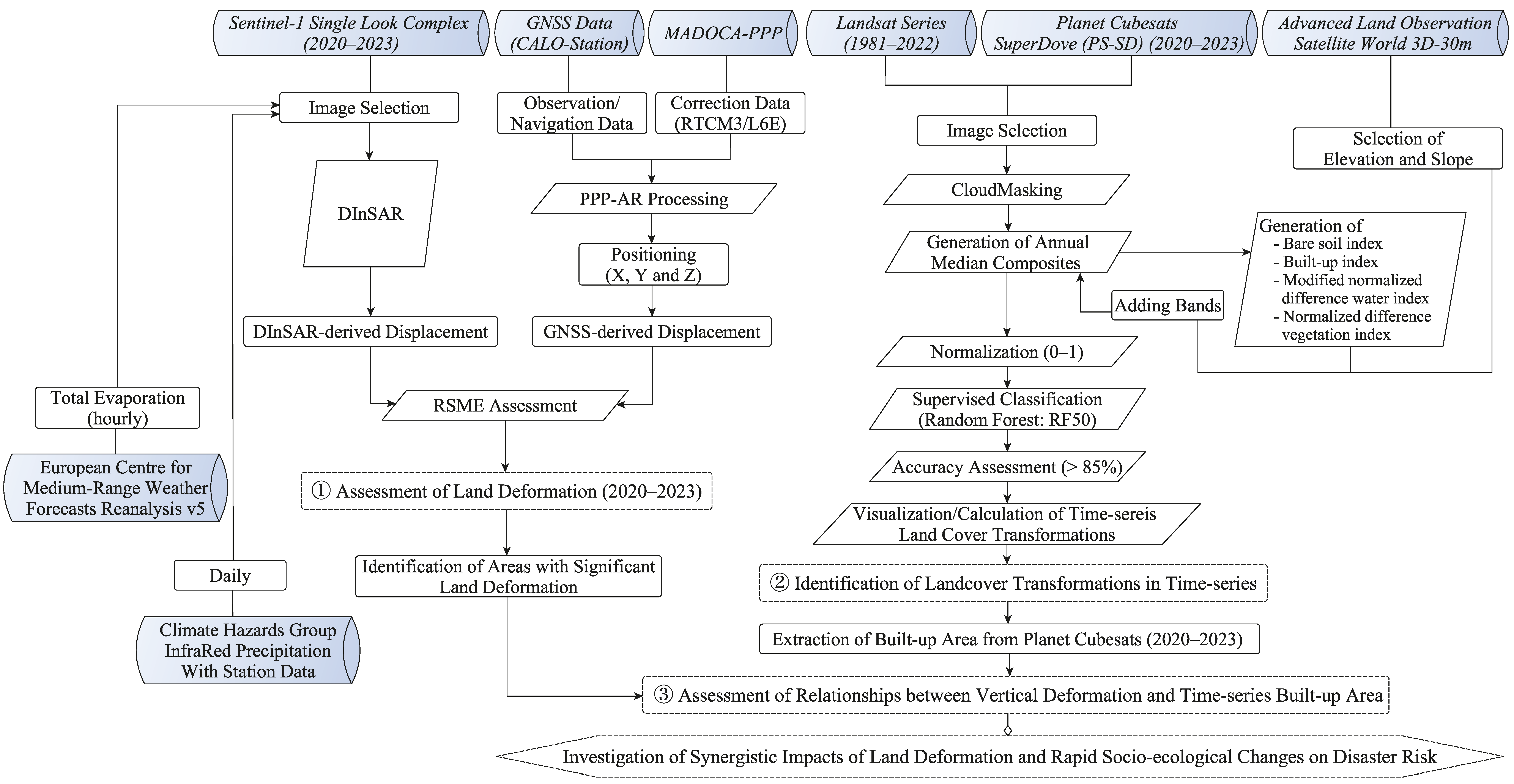
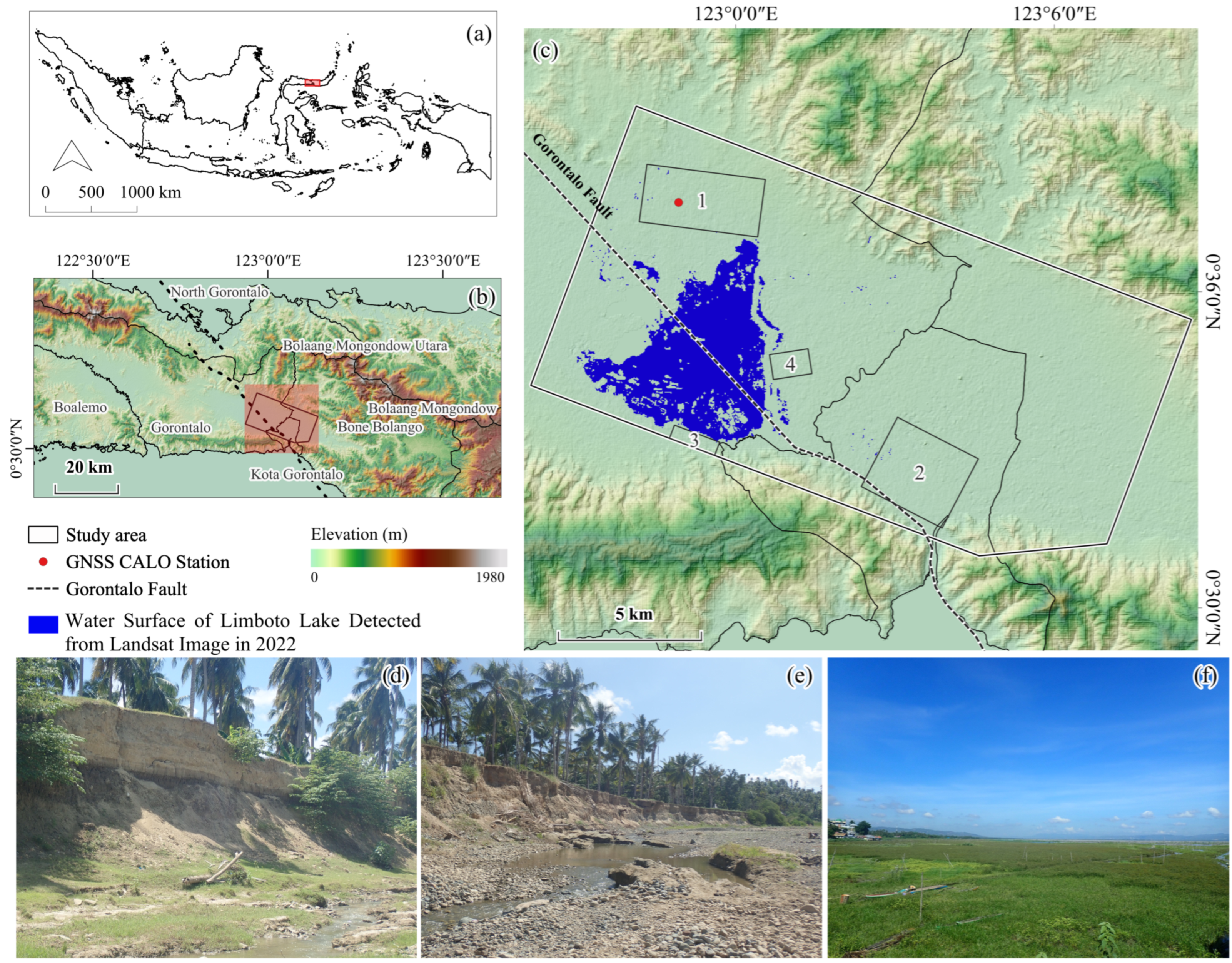
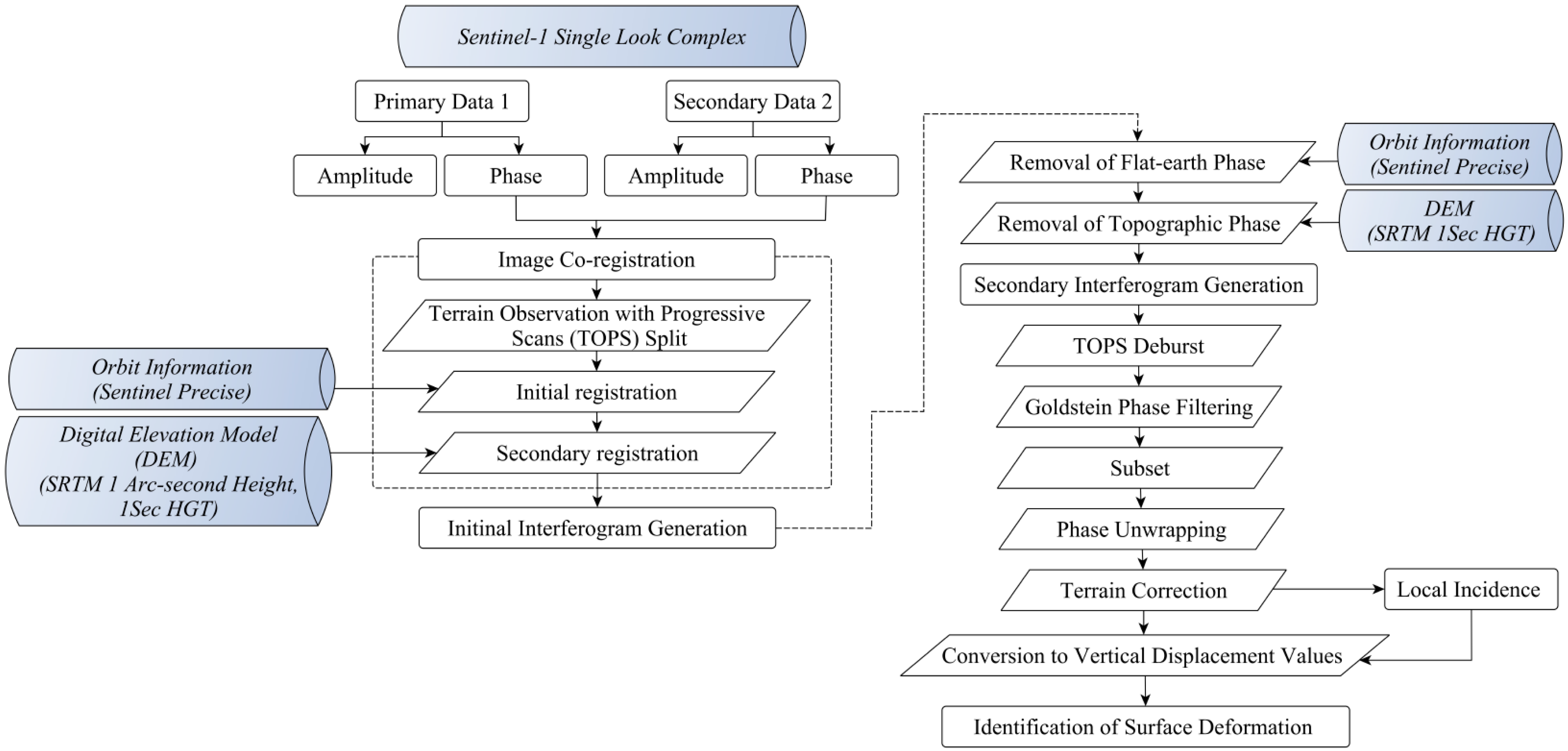

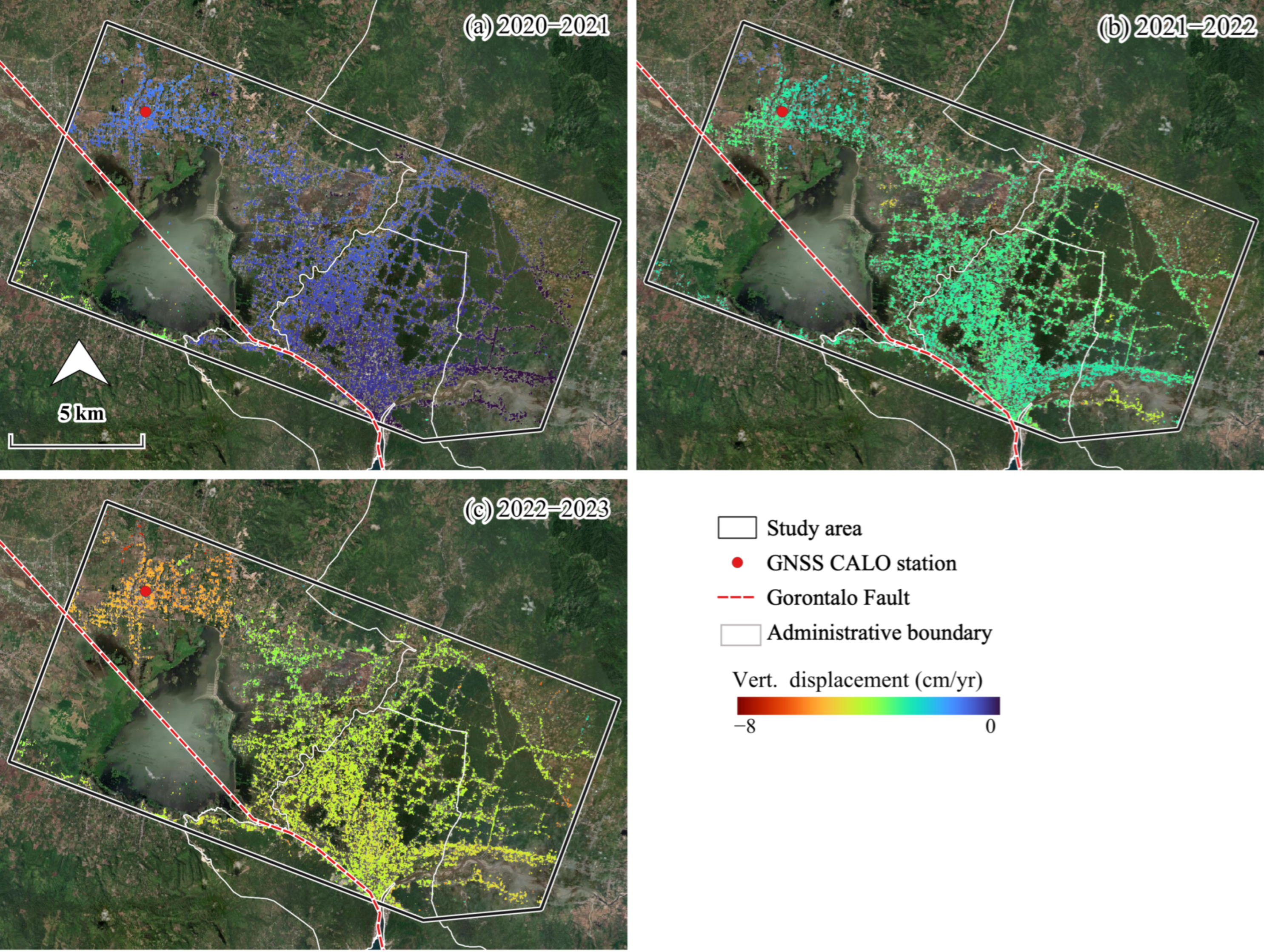

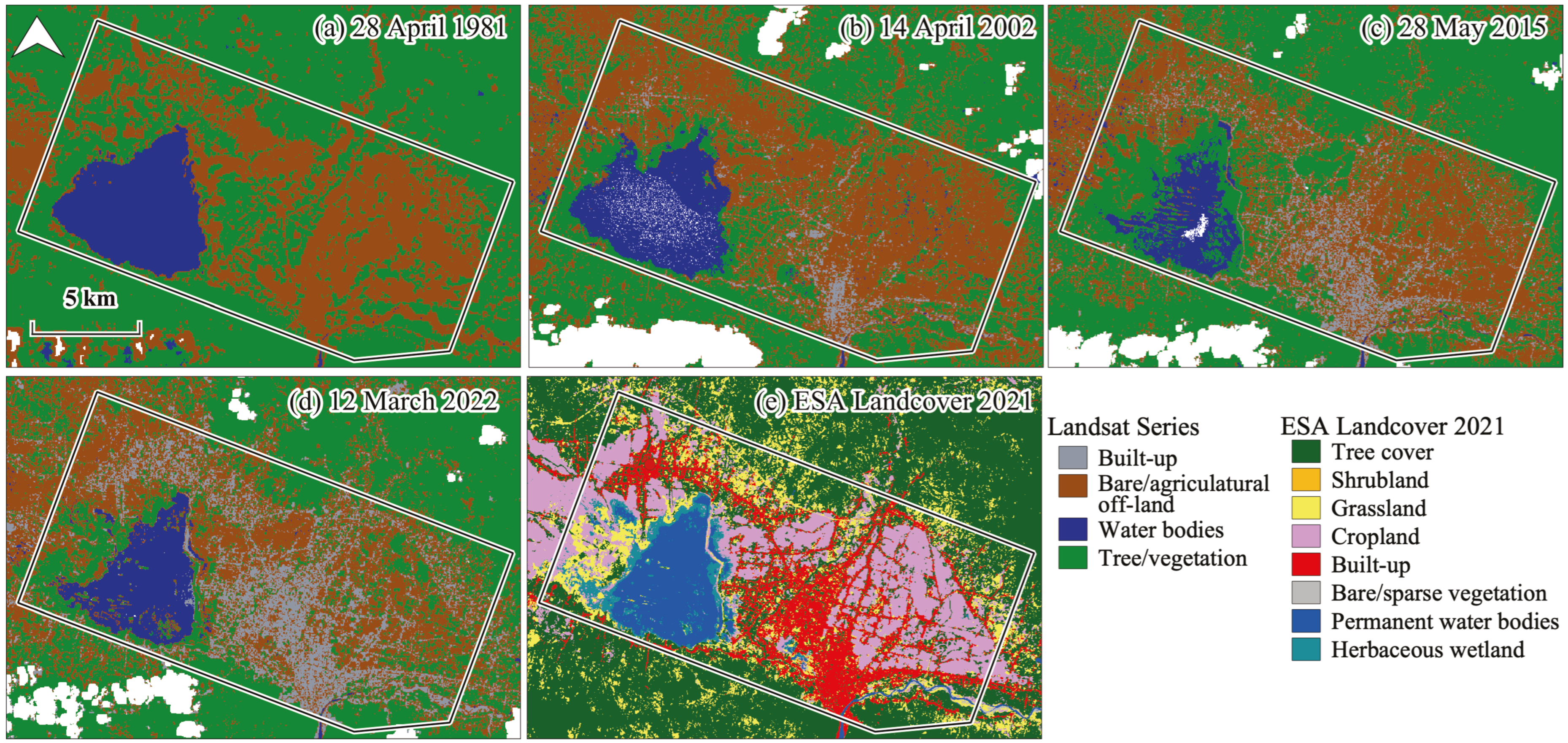

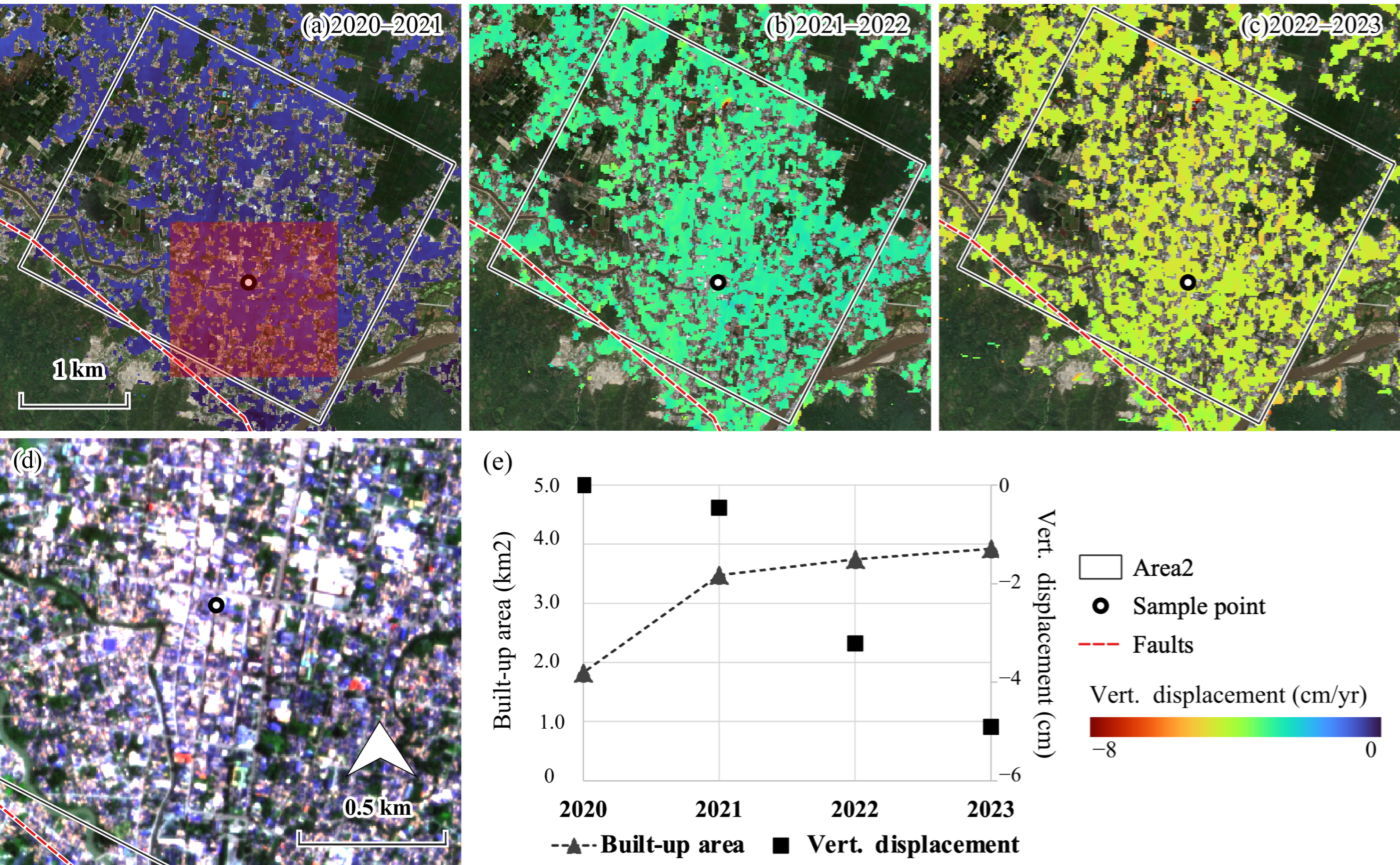

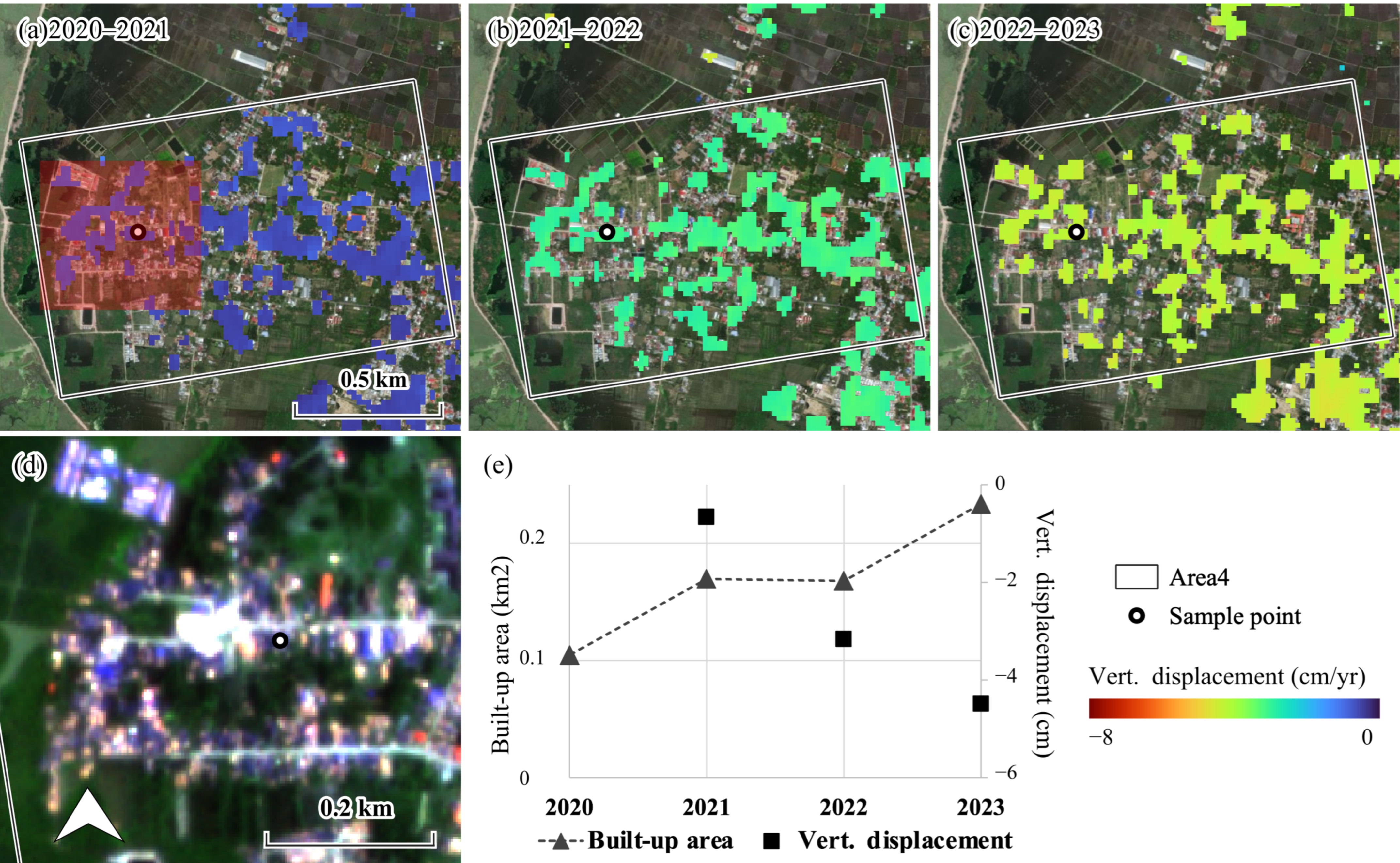
| Instrument (Sensor) | Acq. Date/ Time | Spatial Res. (m) | Temporal Res. (Days) | Operational Mode and Pass (Polarization) | Agency |
|---|---|---|---|---|---|
| Sentinel-1A (C-SAR) | 4 April 2020 11 April 2021 18 April 2022 13 April 2023 | 10 | 12 days | Interferometric Wide swath mode Descending (vertical–vertical) | ESA [35] |
| Landsat2 (MSS) | 28 April 1981 | 60 | 16 days | USGS [38] | |
| Landsat7 (ETM+) | 14 April 2002 | 30 | |||
| Landsat8 (OLI) | 28 May 2015 | ||||
| 12 March 2022 | |||||
| Planet Cubesat (PS2, PS2.SD, PSB.SD) | 9 April 2020 16 April 2021 18 April 2022 10 April 2023 | 3 | 1 day | Planet Scope [39] | |
| CALO Station | 3–5 April 2020 10–12 April 2021 17–19 April 2022 12–14 April 2023 | 30 s | BIG [43] |
| Vertical Displacement (m) | |||||||||||
|---|---|---|---|---|---|---|---|---|---|---|---|
| Years | GNSS | DInSAR | |||||||||
| CALO | 1 | 2 | 3 | 4 | 5 | 6 | 7 | 8 | 9 | ||
| 2020–2021 | −0.0163 | −0.0113 | −0.0104 | −0.0116 | −0.0126 | −0.0136 | −0.0095 | −0.0109 | −0.0116 | −0.0120 | −0.0124 |
| 2021–2022 | −0.0296 | −0.0289 | −0.0312 | −0.0304 | −0.0336 | −0.0323 | −0.0331 | −0.0297 | −0.0294 | −0.0304 | −0.0285 |
| 2022–2023 | −0.0440 | −0.0539 | −0.0525 | −0.0526 | −0.0533 | −0.0556 | −0.0527 | −0.0522 | −0.0526 | −0.0558 | −0.0551 |
| Comparison metrics of statistical measures used to compare the GNSS with each point of DInSAR | |||||||||||
| Bias | −0.0043 | −0.0039 | −0.0046 | −0.0063 | −0.0069 | −0.0046 | −0.0039 | −0.0043 | −0.0056 | −0.0049 | |
| RMSE | 0.0112 | 0.0103 | 0.0105 | 0.0107 | 0.0121 | 0.0112 | 0.0101 | 0.0105 | 0.0122 | 0.0116 | |
| SD | 0.0104 | 0.0096 | 0.0095 | 0.0087 | 0.0099 | 0.0102 | 0.0093 | 0.0096 | 0.0108 | 0.0106 | |
| Pearson correlation | 0.9490 | 0.9744 | 0.9561 | 0.9804 | 0.9526 | 0.9848 | 0.9640 | 0.9476 | 0.9455 | 0.9403 | |
Disclaimer/Publisher’s Note: The statements, opinions and data contained in all publications are solely those of the individual author(s) and contributor(s) and not of MDPI and/or the editor(s). MDPI and/or the editor(s) disclaim responsibility for any injury to people or property resulting from any ideas, methods, instructions or products referred to in the content. |
© 2025 by the authors. Licensee MDPI, Basel, Switzerland. This article is an open access article distributed under the terms and conditions of the Creative Commons Attribution (CC BY) license (https://creativecommons.org/licenses/by/4.0/).
Share and Cite
Kimijima, S.; Nagai, M.; Wani, Z.M.; Bachriadi, D. Synergistic Impacts of Land Deformation and Rapid Socio-Ecological Changes on Disaster Risk in Indonesian Alluvial Plains Using Multiple Satellite Datasets. Remote Sens. 2025, 17, 1514. https://doi.org/10.3390/rs17091514
Kimijima S, Nagai M, Wani ZM, Bachriadi D. Synergistic Impacts of Land Deformation and Rapid Socio-Ecological Changes on Disaster Risk in Indonesian Alluvial Plains Using Multiple Satellite Datasets. Remote Sensing. 2025; 17(9):1514. https://doi.org/10.3390/rs17091514
Chicago/Turabian StyleKimijima, Satomi, Masahiko Nagai, Zahid Mushtaq Wani, and Dianto Bachriadi. 2025. "Synergistic Impacts of Land Deformation and Rapid Socio-Ecological Changes on Disaster Risk in Indonesian Alluvial Plains Using Multiple Satellite Datasets" Remote Sensing 17, no. 9: 1514. https://doi.org/10.3390/rs17091514
APA StyleKimijima, S., Nagai, M., Wani, Z. M., & Bachriadi, D. (2025). Synergistic Impacts of Land Deformation and Rapid Socio-Ecological Changes on Disaster Risk in Indonesian Alluvial Plains Using Multiple Satellite Datasets. Remote Sensing, 17(9), 1514. https://doi.org/10.3390/rs17091514









